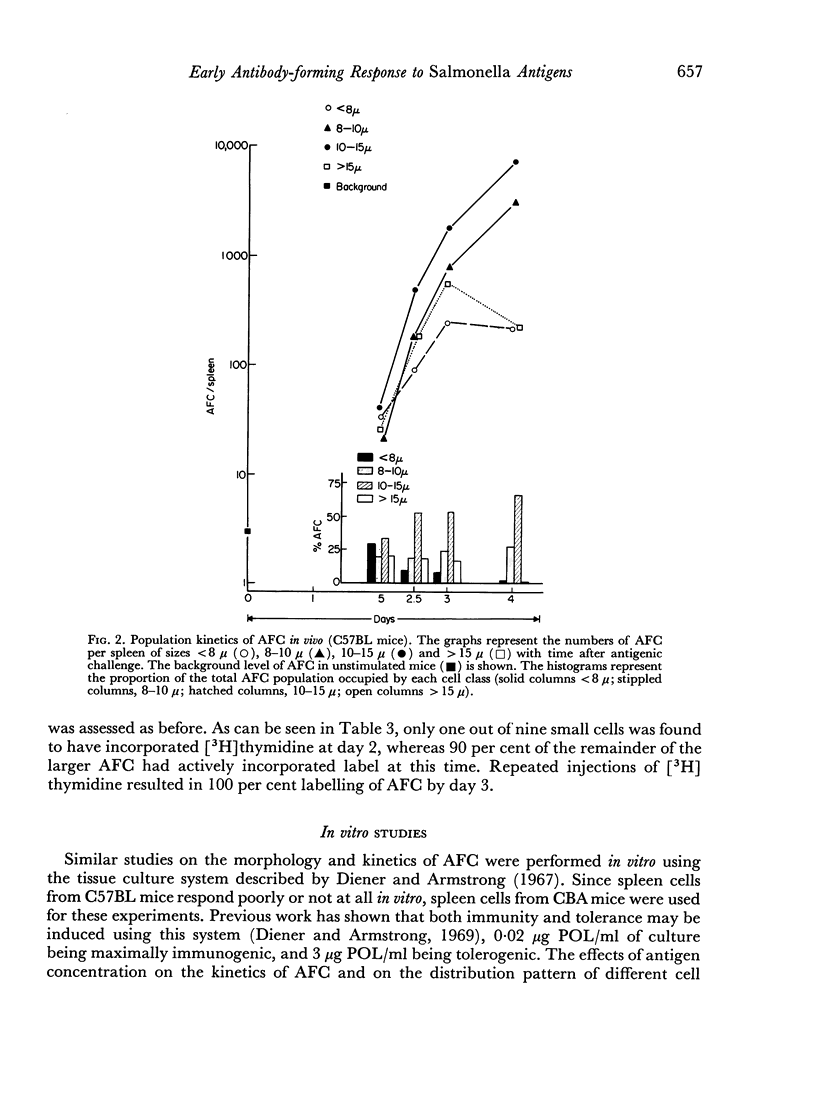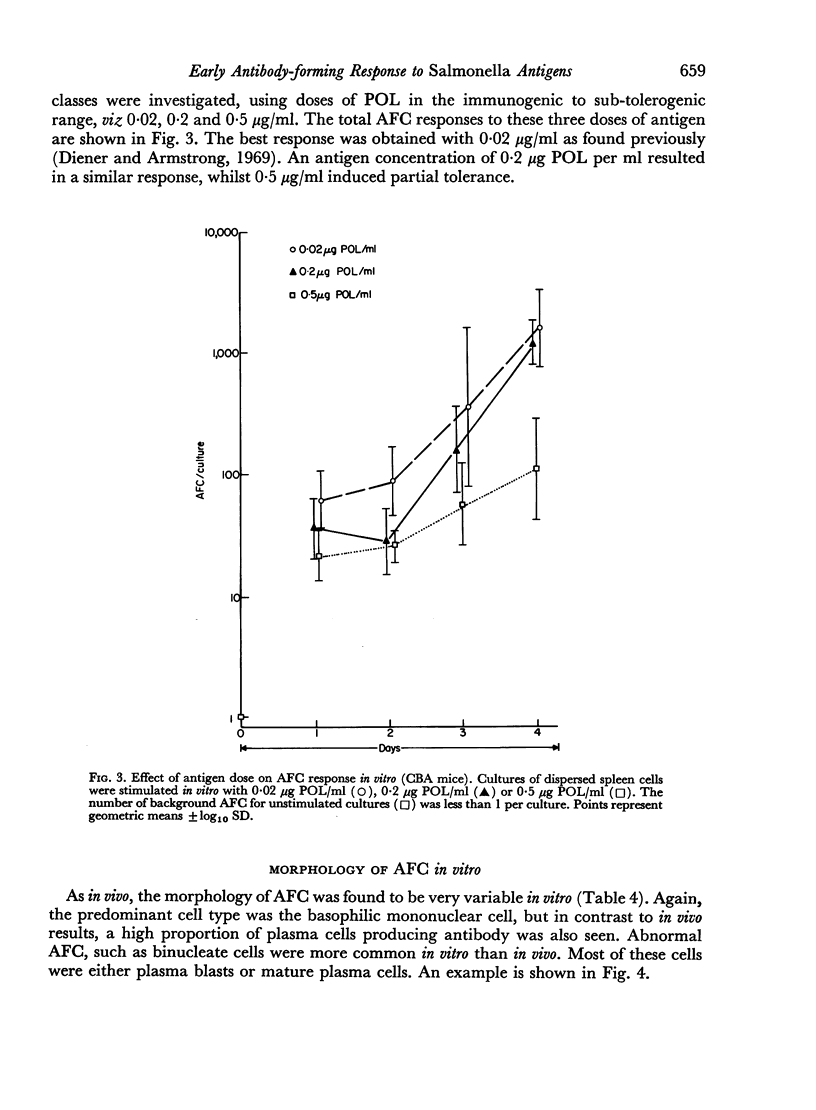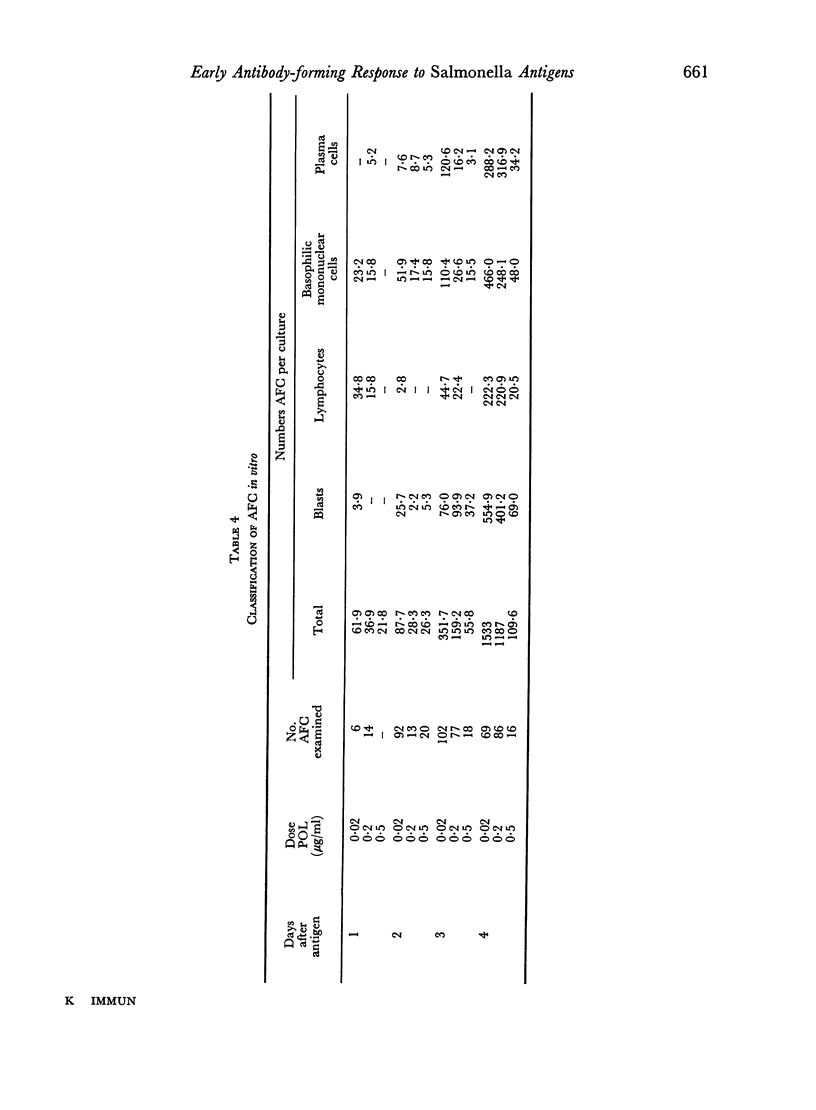Abstract
This paper describes a new method for the morphological study of individual antibody-forming cells (AFC) on cell smears of the quality of normal haematological preparations.
The early AFC response to polymerized flagellin of S. adelaide was studied in vivo using C57BL mice, which have very low background levels of AFC and in vitro using dispersed spleen cell cultures from CBA mice. AFC, arising as a result of in vivo or in vitro stimulation were found to comprise a heterogeneous population, including basophilic mononuclear cells, lymphocytes of most sizes, immature blast cells and occasional plasma cells. The earliest AFC detected comprised a high percentage (28 per cent in vivo, 31 per cent in vitro) of small lymphocyte-like cells. Studies of the incorporation of [3H]thymidine showed that most AFC arose by proliferation but that a proportion of AFC, the small lymphocyte-like cells, arose by differentiation of precursor cells not involving cell division.
The effects of antigen concentration on the kinetics of AFC were investigated in vitro. Subtolerogenic antigen doses caused a delayed and decreased AFC response.
Full text
PDF
















Images in this article
Selected References
These references are in PubMed. This may not be the complete list of references from this article.
- ADA G. L., NOSSAL G. J., PYE J., ABBOT A. ANTIGENS IN IMMUNITY. I. PREPARATION AND PROPERTIES OF FLAGELLAR ANTIGENS FROM SALMONELLA ADELAIDE. Aust J Exp Biol Med Sci. 1964 Jun;42:267–282. [PubMed] [Google Scholar]
- ATTARDI G., COHN M., HORIBATA K., LENNOX E. S. ANTIBODY FORMATION BY RABBIT LYMPH NODE CELLS. I. SINGLE CELL RESPONSES TO SEVERAL ANTIGENS. J Immunol. 1964 Mar;92:335–345. [PubMed] [Google Scholar]
- Ada G. L., Byrt P. Specific inactivation of antigen-reactive cells with 125I-labelled antigen. Nature. 1969 Jun 28;222(5200):1291–1292. doi: 10.1038/2221291a0. [DOI] [PubMed] [Google Scholar]
- BERENBAUM M. C. The autoradiographic localization of intracellular antibody. Immunology. 1959 Jan;2(1):71–83. [PMC free article] [PubMed] [Google Scholar]
- Cunningham A. J. The morphology of antibody-forming cells in the mouse. Aust J Exp Biol Med Sci. 1968 Apr;46(2):141–153. doi: 10.1038/icb.1968.12. [DOI] [PubMed] [Google Scholar]
- Diener E. A new method for the enumeration of single antibody-producing cells. J Immunol. 1968 May;100(5):1062–1070. [PubMed] [Google Scholar]
- Diener E., Armstrong W. D. Immunological tolerance in vitro: kinetic studies at the cellular level. J Exp Med. 1969 Mar 1;129(3):591–603. doi: 10.1084/jem.129.3.591. [DOI] [PMC free article] [PubMed] [Google Scholar]
- Diener E., Armstrong W. D. Induction of antibody formation and tolerance in vitro to a purified protein antigen. Lancet. 1967 Dec 16;2(7529):1281–1285. doi: 10.1016/s0140-6736(67)90394-7. [DOI] [PubMed] [Google Scholar]
- Dutton R. W., Mishell R. I. Cell populations and cell proliferation in the in vitro response of normal mouse spleen to heterologous erythrocytes. Analysis by the hot pulse technique. J Exp Med. 1967 Sep 1;126(3):443–454. doi: 10.1084/jem.126.3.443. [DOI] [PMC free article] [PubMed] [Google Scholar]
- Eidinger D., Pross H. F. The immune response to sheep erythrocytes in the mouse. I. A study of the immunological events utilizing the plaque technique. J Exp Med. 1967 Jul 1;126(1):15–33. doi: 10.1084/jem.126.1.15. [DOI] [PMC free article] [PubMed] [Google Scholar]
- HALL J. G., MORRIS B. The lymph-borne cells of the immune response. Q J Exp Physiol Cogn Med Sci. 1963 Jul;48:235–247. doi: 10.1113/expphysiol.1963.sp001660. [DOI] [PubMed] [Google Scholar]
- HELMREICH E., KERN M., EISEN H. N. The secretion of antibody by isolated lymph node cells. J Biol Chem. 1961 Feb;236:464–473. [PubMed] [Google Scholar]
- Hall J. G., Morris B., Moreno G. D., Bessis M. C. The ultrastructure and function of the cells in lymph following antigenic stimulation. J Exp Med. 1967 Jan 1;125(1):91–110. doi: 10.1084/jem.125.1.91. [DOI] [PMC free article] [PubMed] [Google Scholar]
- Henry C., Jerne N. K. Competition of 19S and 7S antigen receptors in the regulation of the primary immune response. J Exp Med. 1968 Jul 1;128(1):133–152. doi: 10.1084/jem.128.1.133. [DOI] [PMC free article] [PubMed] [Google Scholar]
- INGRAHAM J. S., BUSSARD A. APPLICATION OF A LOCALIZED HEMOLYSIN REACTION FOR SPECIFIC DETECTION OF INDIVIDUAL ANTIBODY-FORMING CELLS. J Exp Med. 1964 Apr 1;119:667–684. doi: 10.1084/jem.119.4.667. [DOI] [PMC free article] [PubMed] [Google Scholar]
- INGRAHAM J. S. DYNAMIC ASPECTS OF THE FORMATION OF SERUM ANTIBODY IN RABBITS. EXPONENTIAL AND ARITHMETIC PHASES IN THE RISE OF TITER FOLLOWING A REINJECTION OF SULFANILAZO BOVINE-GAMMA-GLOBULIN. J Immunol. 1964 Feb;92:208–222. [PubMed] [Google Scholar]
- JERNE N. K., NORDIN A. A. Plaque formation in agar by single antibody-producing cells. Science. 1963 Apr 26;140(3565):405–405. [PubMed] [Google Scholar]
- Koros A. M., Mazur J. M., Mowery M. J. Radioautographic studies of plaque-forming cells. I. Antigen-stimulated proliferation of plaque-forming cells. J Exp Med. 1968 Aug 1;128(2):235–257. doi: 10.1084/jem.128.2.235. [DOI] [PMC free article] [PubMed] [Google Scholar]
- Marbrook J. Primary immune response in cultures of spleen cells. Lancet. 1967 Dec 16;2(7529):1279–1281. doi: 10.1016/s0140-6736(67)90393-5. [DOI] [PubMed] [Google Scholar]
- NOSSAL G. J. Antibody production by single cells. Br J Exp Pathol. 1958 Oct;39(5):544–551. [PMC free article] [PubMed] [Google Scholar]
- NOSSAL G. J., MAKELA O. Autoradiographic studies on the immune response.I. The kinetics of plasma cell proliferation. J Exp Med. 1962 Jan 1;115:209–230. doi: 10.1084/jem.115.1.209. [DOI] [PMC free article] [PubMed] [Google Scholar]
- NOSSAL G. J., SZENBERG A., ADA G. L., AUSTIN C. M. SINGLE CELL STUDIES ON 19S ANTIBODY PRODUCTION. J Exp Med. 1964 Mar 1;119:485–502. doi: 10.1084/jem.119.3.485. [DOI] [PMC free article] [PubMed] [Google Scholar]
- Paul W. E., Siskind G. W., Benacerraf B. Specificity of cellular immune responses. Antigen concentration dependence of stimulation of DNA synthesis in vitro by specifically sensitized cells, as an expression of the binding characteristics of cellular antibody. J Exp Med. 1968 Jan 1;127(1):25–42. doi: 10.1084/jem.127.1.25. [DOI] [PMC free article] [PubMed] [Google Scholar]
- Szenberg A., Cunningham A. J. DNA synthesis in the development of antibody-forming cells during the early stages of the immune response. Nature. 1968 Feb 24;217(5130):747–748. doi: 10.1038/217747a0. [DOI] [PubMed] [Google Scholar]
- Tannenberg W. J. Induction of 19S antibody synthesis without stimulation of cellular proliferation. Nature. 1967 Apr 15;214(5085):293–295. doi: 10.1038/214293a0. [DOI] [PubMed] [Google Scholar]
- Tannenberg W. J., Malaviya A. N. The life cycle of antibody-forming cells. I. The generation time of 19S hemolytic plaque-forming cells during the primary and secondary responses. J Exp Med. 1968 Nov 1;128(5):895–925. doi: 10.1084/jem.128.5.895. [DOI] [PMC free article] [PubMed] [Google Scholar]
- ZAALBERG O. B. A SIMPLE METHOD FOR DETECTING SINGLE ANTIBODY-FORMING CELLS. Nature. 1964 Jun 20;202:1231–1231. doi: 10.1038/2021231a0. [DOI] [PubMed] [Google Scholar]




